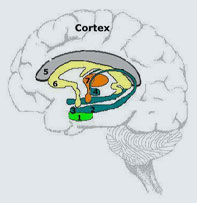The area of short-term memory is located in the lower part of the temporal lobe and is of great importance for the temporary storage (a few tens of seconds) of an event, before it is eventually and lastingly preserved.
The temporal area is part of the limbic system.
The temporal area of short-term memory is an integral part of a region located inside the cerebral hemispheres: the limbic system (see the figure below showing a brain seen in profile).

- 1. Entorhinal cortex: it acts as an intermediary between the hippocampus and the cortex.
- 2. Hippocampus: it transforms a specific (taking into account the spatio-temporal context) and recent event into a new memory. It therefore makes it possible to permanently remember specific information or events.
- 3. Amygdala
– Involved in emotional memory (it gives an emotional dimension to memories).
– Also involved in social behavior. - 4. Mammilary bodies, involved in controlling mood.
- 5. Cingulate gyrus: controls behavior.
- 6. Septum: it moderates the emotions.
- 7. Thalamus: it makes the link between the cortex and the limbic system (without it the cortex does not “work”). It is involved in episodic memory.
Many studies have looked at the role of two structures present in this area and closely linked to memory: the hippocampus and the entorhinal cortex.
The hippocampus and the entorhinal cortex are particularly vulnerable to the effects of aging, since damage to these two structures is observed in older people with mild cognitive impairment or Alzheimer’s disease. There is therefore a link of cause (lesions) and effect (cognitive disorders).
These structures are more rarely affected during a cerebrovascular accident while they are generally spared in an elderly person without any cognitive deficit.
